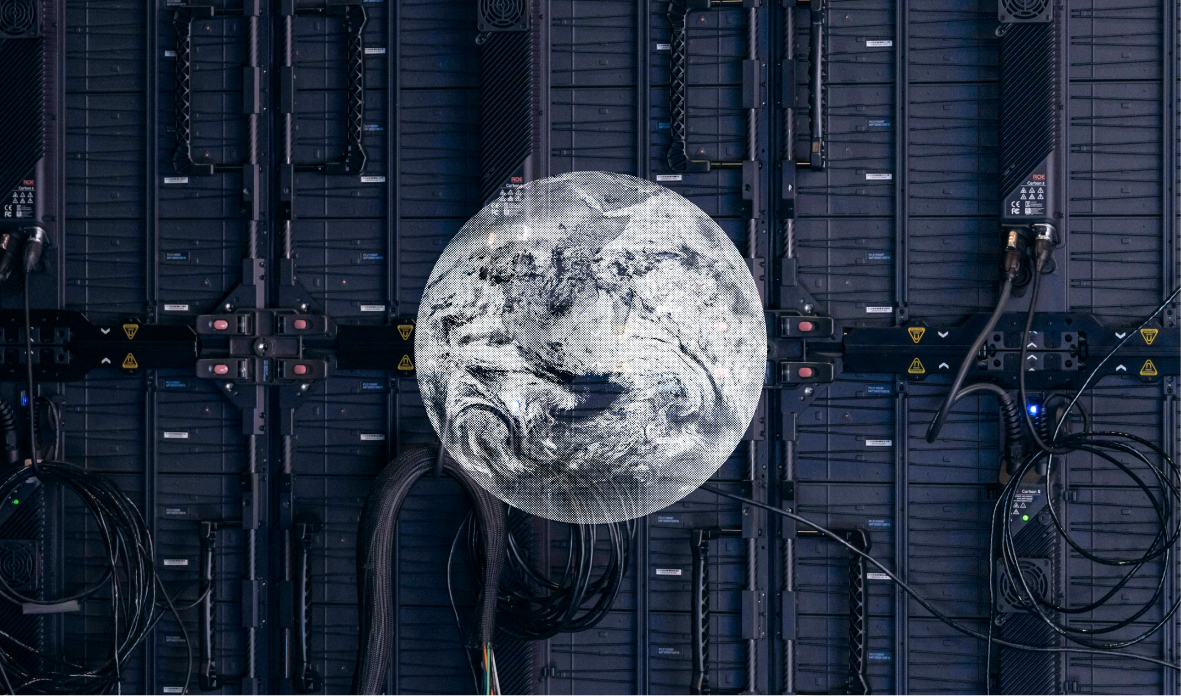Commons’ Commitment to Responsible AI Use

Join the community





As a technology company working to address the climate crisis, we realize that AI use comes with a substantial, growing footprint. It also opens up opportunities to move faster in support of our mission. Balancing those two truths is no easy feat.
Can we use AI responsibly? And how do we continue to quantify its impact to keep ourselves and AI companies accountable?
That’s what this living document is for. Our commitment to responsible AI use will remain steadfast, and as we learn, we’ll update our learnings here.
A Primer on AI’s resource usage
When we talk about the climate impact of AI, most of it comes from the environmental impact of data centers. These data centers are all over the world, spanning millions of square feet. Within those data centers are servers. Every AI query — search prompt, image edit, writing prompt — requires these servers to run computations, and running those computations requires a lot of energy. On top of that, keeping the servers from overheating requires a lot of water.
Essentially, every time we use AI, we’re accessing one of these data centers and using a bit of power, a bit of water, and a bit of the lifetime of the materials that make up the servers.
This is very similar to what happens when we use other online software. For example, when you search something on Google, you’re basically Google’s servers to search the internet and bring back relevant information. The reason AI has taken off so quickly is that it does more “work” than a basic search. It doesn’t just surface a list of links; it can read, comprehend, and relay large swaths of information.
This is why AI use is skyrocketing. As AI becomes more popular, tech companies are building more data centers to meet current and prospective demand. Each new data center requires more energy, more water, and more land.
Emissions from tech — specifically Information and Communications Technology — are around 1.5-4%. Put that in perspective, that’s about the same amount of emissions as the global aviation industry (2.5%). With the expansion of AI, that number could go up by 2-6 times.
The U.S. has more data centers than any other country in the world. By 2030, it’s predicted that almost half of the growth in U.S. energy demand will come from data centers. By 2027, the world will need as much water as all of New Zealand to keep data centers cool.
That’s why this moment is so critical. We’re only a couple of years into the mainstream AI boom, and the industry is growing rapidly with few restrictions. So it’s up to governments, tech companies, and consumers to do what we can to drive a more responsible future for AI.
Measuring the Impact of AI
We’re still in the early days of AI. It’s a bit like the Wild West – big tech companies are rapidly building data centers with little regulation. Exacerbating the issue is the fact that in energy reporting, AI isn’t accounted for in its own sector. The US Energy Information Administration is able to make some projections, but there isn’t yet any detailed data
The U.S. has many more data centers than any other country — about 5,500. Next is Germany with about 10% that amount. Here in the U.S., many states have enacted or proposed AI legislation that can do the important work of protecting consumers from security issues with AI. But as of October 2025, Massachusetts is the only state that has put forward a bill that includes any regulation around AI’s emissions or resource documentation. The EU has taken steps toward regulation with the EU Artificial Intelligence Act that will be implemented by 2026.
Big tech companies like OpenAI, Google, and Meta are leading the charge on AI. Unfortunately, these companies have yet to release enough detailed carbon accounting on their AI usage to make educated energy projections. (As of October, 2025)
There is some early data on the environmental impact of AI available. But today, much of it has faced limited peer review or has been published in an ad-hoc manner. For instance, an oft-cited stat on the energy and water impact of a ChatGPT query comes from a blog post Sam Altman published in June 2025: "the average query uses about 0.34 watt-hours, about what an oven would use in a little over one second… It also uses about 0.000085 gallons of water; roughly one fifteenth of a teaspoon."
Academic institutions like MIT and Carnegie Mellon University, international organizations like the United Nations Environmental Programme, and major technology companies like Google and OpenAI are starting to conduct and publish more research on this topic.
But what isn’t yet reflected in the data is the impact that these tech companies are having on local communities by building and running these data centers. To build data centers, companies need a lot of land, energy, and water in the cities where they’re building.
This means that these data centers are having drastic effects on local communities and ecosystems. For instance, electricity prices are rising for Americans for a number of reasons, one of which is the rapid expansion of data centers. According to PowerLines, “in Q2 2025, utilities requested or received approval for over $9 billion in rate increases.”
In some counties in the U.S., data center expansion has impacted not only utility costs but also access. When a new data center uses more of the city’s water supply, this can affect the clean water supply for residents. In Newton County, GA, residents have complained about low water pressure and supply after Meta built a $750 million data center nearby.
We believe it’s crucial that responsible AI usage goes beyond simply accounting for the emissions of our AI use. At these early stages of AI, now is the time to fervently advocate for broader understanding, transparency, and accountability for AI. At Commons, we’re doing what we can to stay accountable and transparent about our own AI usage.
Tracking Our AI Usage and Impact
It’s important to place our AI use and impact in the context of our overall impact as a company. We will give a fuller picture of the environmental impact of our AI use as part of our 2025 Impact Report that we’ll release in spring 2026.
But we do have a high-level picture of the impact of our AI usage today:
- Our entire team shares one AI account so we can more accurately track and account for teamwide usage, query volume, and other data.
- Our team uses Open AI’s Chat GPT and Anthropic as our primary AI tools. We know that when we support better companies, we’re supporting a better world, and we actively trial various options before picking the best one for each of our use cases.
An important part of how we think about when to use AI is considering if the pros outweigh the cons. We will continue to weigh and document our decisions to stay accountable as we continue to adapt to changing technology.
How Commons Does (and Doesn’t) Use AI
While a lot of AI’s popularity has come from viral photo trends on social media, work slop, and questionable medical advice, it is enabling meaningful breakthroughs with real environmental impact.
AI has been used to accelerate the transition to renewable energy with more reliable forecasting. Teams are using AI to measure deforestation across more than 1 million hectares of land around the world. Scientists are using AI to track the speed at which icebergs are melting, and they’re doing it 10,000 times faster than they could with humans alone. Modeling with AI is helping to inform earlier preparation for climate disasters. It’s even being used to map litter in the oceans.
As a company whose mission is centered on collective climate impact, we’re focused on using AI as a tool to help us achieve our mission faster. It’s important that our AI use doesn’t cause more harm than good.
Here’s our approach:
AI is a tool that, at present, comes with a rapidly rising environmental cost that can’t be underestimated. At Commons, we believe that if we choose to use AI, we should do so with scrutiny.
We use AI in multiple ways to enhance our work. We use AI:
- As an aid to augment our small team and make our work more efficient (e.g. support in writing and debugging code)
- To collect and analyze large swaths of complex data and unstandardized information (e.g. reformatting large datasets, identifying and analyzing public reporting for brand ratings)
- To quickly trial new processes and formats before investing team time in a project (e.g. rapidly prototyping new sites)
Commons does not use AI:
- To auto-generate creative content: We occasionally use AI to help ideate and draft content, but all of our final content is curated, refined, and developed by our team. We avoid using AI-generated images, including from other sources like stock websites.
- To make hiring decisions: We may use AI to assist in screening resumes and doing admin tasks, but our decisions about who to hire are made entirely by our team with much care.
- To evaluate team performance: We have a very hands-on approach to employee performance. We do not use AI to monitor, analyze, or grade our teams’ work.
An important part of how we think about when to use AI is considering if the pros outweigh the cons. We will continue to weigh and document our decisions to stay accountable as we continue to adapt to changing technology.













